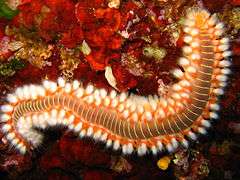Bearded fireworm
| Bearded fireworm | |
|---|---|
 | |
| Bearded Fireworm | |
| Scientific classification | |
| Kingdom: | Animalia |
| Phylum: | Annelida |
| Class: | Polychaeta |
| Subclass: | Errantia |
| Order: | Amphinomida |
| Family: | Amphinomidae |
| Genus: | Hermodice |
| Binomial name | |
| Hermodice carunculata (Pallas, 1766) | |
The bearded fireworm (Hermodice carunculata) is a type of marine bristleworm belonging to the Amphinomidae family, native to the tropical Atlantic Ocean and the Mediterranean Sea.
Description
Bearded fireworms are usually 15 centimetres in average length, but can reach up to 30 centimetres.[1][2]
At first glance, this fire worm looks like a centipede with its elongated and flattened appearance, multiple segments, white silks, and parapodia and gills located on the side of its body. Its colors are varied and range from greenish, to yellowish, to reddish, grayish through white with a pearly glow. The body consists of 60 to 150 identical segments separated from each other by a thin white line and protected by cuticles.[1] Each segment has a pair of parapodia, a structure for locomotion, clusters of stinging white bristles, and red or orange gills all in bilateral position. The anterior part of the worm can be recognized by small growths, called caruncle, which have the same color of the gills on the first four segments. The mouth is ventral and is located on the second segment. The head is shown on the first segment and includes the eyes and other sensory organs.
Distribution and habitat
The bearded fireworm lives throughout the tropical coastal waters of the Atlantic Ocean. On the eastern side they are found from Algeria to Liberia, and on the western side from the southeast coast of the United States of America to Guyana, including the Gulf of Mexico and the Caribbean Sea. They are also found in the eastern area of the Mediterranean Sea around the Maltese archipelago and near an island Mamula in Montenegro.[3][1]
This fireworm is found in many marine living environments such as corals, rocks, mud, sand, posidonia, and on drifting wood as well as port infrastructure in shallow water from the surface to 40 meters deep.[2]
Biology
The bearded fireworm is a voracious predator and feeds on dead or decaying organisms and coral polyps.
The bearded fireworm is a slow creature, and is not considered a threat to humans unless touched by a careless swimmer. The bristles, when flared, can penetrate human skin, injecting a powerful neurotoxin and producing intense irritation and a painful burning sensation around the area of contact. The sting can also lead to nausea and dizziness. This sensation lasts up to a few hours, but a painful tingling can continue to be felt around the area of contact. In a case of accidental contact, application and removal of adhesive tape will help remove the spines; applying isopropanol to the area may help alleviate the pain.
The transcriptome of the bearded fireworm was sequenced and annotated in 2015.[4]
Gallery
-
.jpg)
Bearded fireworm
-

Bearded fireworm from the Mediterranean
References
- 1 2 3 de Kluijver, M.J.; Ingalsuo, S.S.; de Bruyne, R.H. (2000) Macrobenthos of the North Sea [CD-ROM]: 1. Keys to Mollusca and Brachiopoda. World Biodiversity Database CD-ROM Series. Expert Center for Taxonomic Identification (ETI): Amsterdam, The Netherlands. ISBN 3-540-14706-3. 1 cd-rom pp.,
- 1 2 M. De Kluijver, G. Gijswijt, R. de Leon & I. da Cunda, "Interactive Guide to Caribbean Diving.",CD-ROM, Expertise-Centrum voor Taxonomische Identifikatie, 2003, ISBN 978-9075000511
- ↑ DIDIERLAURENT Sylvie, DESVIGNES Thomas, in : DORIS, 7/12/2014 : Hermodice carunculata (Pallas, 1766), http://doris.ffessm.fr/fiche2.asp?fiche_numero=882
- ↑ Mehr, S.F.M., Verdes, A., DeSalle, R., Sparks, J., Pieribone, V. and D. F. Gruber. 2015. Transcriptome sequencing and annotation of the polychaete Hermodice carunculata (Annelida, Amphinomidae)”, BMC Genomics, 16:445. http://bmcgenomics.biomedcentral.com/articles/10.1186/s12864-015-1565-6
Bibliography
- Greenberg, Idaz (1986). Guide to Corals & Fishes of Florida, the Bahamas and the Caribbean. Seahawk Press. p. 61. ISBN 0-913008-08-7.